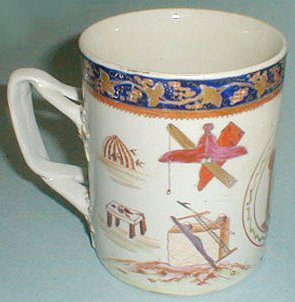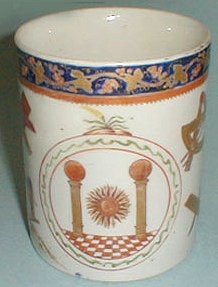Early Chinese
Export Masonic Mug




Here is a beautiful porcelain Chinese Export Mug
circa 1800-1820. It is decorated with polychrome Masonic symbols.
The central design is of the pillars of Boaz and Jachin surmounted with the
globes. Underneath is the checkered pavement of good and evil with a
blazing sun/star containing the Letter "G". On either side are the
beehive, a symbol of industry; an altar picturing some working tools above, a
workbench, rough ashlar, and a Square and Compasses resting on the Holy Bible.
The border design is a blue field with gold grapevine design. The handle
is also designed with a grapevine motif. It measures 5 1/2 inches tall
and 4 1/4 inches in diameter.
Freed from British Trade
restrictions following the American independence, Americans lost no time in
establishing trade with China. The first American ship involved in the
China Trade was the "Empress of China," which sailed from New York
in 1784. Other American merchants quickly followed and began importing
teas, spices, silks, and ceramics like the cider pitcher seen above.
Chinese porcelain was a particularly important item. By the time
Americans entered the China Trade, the Chinese had already developed certain
stock patterns, several of which used Masonic symbols. Since symbolism
plays an important part in Chinese art, Chinese decorators must have felt a
degree of familiarity in working with designs and symbols.
Another type of Masonic
decoration imported to America were personal monograms with a pseudo-armorial
design of Masonic emblems. The forms of Masonic decorated China Trade
porcelain are primarily mugs, punch bowls, tea and coffee pots, and more
rarely, entire tea sets. The notebook of an American trader dated 1797,
in the collection of the Rhode Island Historical Society, lists the
"Price current at Canton for Chinaware" and includes 1 to 1 1/2
gallon Masonic bowls for 2 to 3 dollars each, and Masonic pint mugs for 20
dollars a hundred. Most of this porcelain was for private use, although
the history of some of the larger punch bowls definitely suggests that they
were used in Lodges.

